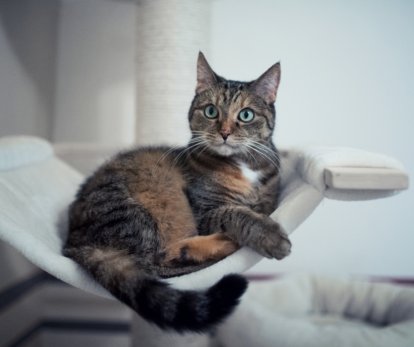Veganism and Religion: What Hinduism, Buddhism, Sikhism, and Jainism can teach us about our fellow animals (Part 2 of 3)


How would you feel if you were shut in a small room with barely enough room to move, little companionship (if any) and nothing to keep you entertained?
It would soon impact your physical and mental health, wouldn’t it?
Or what if, when you tried to express a preference, you were ignored, forced to act against it or, worse yet, punished for “bad behaviour”?
Sadly, this is the reality for a huge number of the non-human animals who share our homes and lives through no choice of their own.
We have to do better.
In another blog, we looked at how problematic the domestication of non-human animals is and why “pet ownership” always tips the balance in favour of humans to the detriment of our non-human animal companions.
Although we hope for a day when keeping non-human animals as pets will be a thing of the past, we can’t ignore what’s happening to millions of them right now, even in nations where people claim to be animal lovers.
Many of the non-human animals we call our friends and family members are only on this earth for a short amount of time. What can we do to make that time as fulfilling as possible?
We can start with these three words: enrichment, choice and consent.
At its core, enrichment is about giving non-human animals opportunities to express their natural, species-typical behaviours, as well as control or choice over their environment whenever it’s safe to do so.
Not only does this look different for each species of animal but it will also vary hugely from one individual to another within the same species.
As good guardians to our non-human family members, we have a responsibility to observe how they respond to enrichment and give them ongoing opportunities to do what brings them joy and satisfaction.
Thankfully, there is growing recognition that enrichment is just as important as good nutrition or veterinary care. The challenge remains to get that message out to the wider world.
As we’ve mentioned above, what constitutes enrichment varies across species but also between individuals.
For a dog, enrichment might include opportunities to sniff, find scattered food, dig and chase, play tug, solve puzzles, and much more. This could be provided in the form of a stuffed Kong instead of a food bowl, hiding treats around the house or garden, letting the dog sniff as much as they want when out for a walk and so on.
Enrichment for cats could include opportunities for climbing, playing, chasing or using puzzle feeders to link food to opportunities for mental and physical exertion. You might offer a variety of shelves of different heights that cats are free to climb on or provide furniture like a cat tree. Equally, an empty cardboard box to play with or dangling toys tied to door handles can all enable cats to express their natural behaviours.
Smaller animals such as rats, guinea pigs, rabbits, hamsters, gerbils or chinchillas need enrichment too, as do birds such as cockatiels, budgies, finches and lovebirds. Indeed, all animals – whether human or non-human – will suffer without enrichment.
Rabbits are active, inquisitive, social and intelligent beings. They need space to be able to run, jump, hop and rear up on their hind legs, as well as safe places to hide. In addition, they should always have access to a choice of objects to manipulate, investigate, encourage play and allow digging and scent marking. Rabbits would naturally forage for food and graze hay and grass all day, so they must be able to do this.
Similarly, guinea pigs will suffer in a small hutch. They need a large, flat space to be able to run, popcorn and play with one another, as well as safe places to hide. Like rabbits, they need opportunities to graze all day and 80% of their diet should come from good quality hay. Giving them big piles of hay to eat, sleep in and play with is a fantastic form of enrichment. Even something as simple as stuffing an empty toilet roll tube with hay will bring a guinea pig pleasure. Above all, they need a companion of the same species.
These are just a few examples. There are many more and we’d urge you to keep exploring what they might be.
If you share your life with a non-human animal companion, a priority has to be learning as much as possible about what constitutes enrichment for them and then giving them opportunities to express their natural preferences.
Every day, you make hundreds of choices, big and small, about how to spend your time. Without the opportunity to make these choices and control aspects of your life, the odds are that you would soon become stressed and depressed.
We now know that when any animal is deprived of choice, it can lead to negative consequences such as creating a state of “learned helplessness”. This is when an individual learns that they are unable to influence their circumstances or environment. Learned helplessness can cause intense psychological distress.
As guardians to non-human animals, we need to constantly explore how we can offer our companions more autonomy.
This could include a choice of places to sleep, different types of food offered in different ways, the option to move away from stressful things and so on.
Often, providing choice requires us to step back. We, humans, believe that we can and must control other animals but, in doing so, we rob them of their right to self-govern.
ACE Free Work is an approach that’s all about minimising human control and giving other animals choice. Although it was developed to support dogs, many of the principles can be applied to other animal companions.
With Free Work, the aim is to provide a space filled with lots of different textures, surfaces, activities, food and access to water. The individual animal is then given complete freedom to move through and interact with the space as they choose without any human input.
If you take time to watch a dog, for example, engaging with Free Work, it can provide a phenomenal amount of information about their personal preferences, areas where they lack confidence and even if they are experiencing pain or discomfort anywhere in the body.
How can you give more choice to your animal kin?
Understanding non-human animals as individuals means that we also have to respect their bodily autonomy and rights.
As primates, we humans show love and affection through touch. We kiss, hug and stroke those we cherish but for many other species of animal, this kind of physical attention can be uncomfortable.
How often do we hear people say that a dog bit a human child “out of the blue” or a cat scratched someone “without warning” or that a hamster bit the person holding them?
But do any of these events really happen out of the blue?
In reality, many non-human animals use clear body language to ask for space and tell us that they’re uncomfortable with primate-style interactions. Dogs, for example, use small but telling gestures such as licking their lips, yawning, putting their ears back, turning their heads away, sniffing or showing the whites of their eyes to say that they’re worried. These pleas for personal space are often ignored until the individual dog is forced to escalate.
Guinea pigs use different vocalisations such as high-pitched squeaks, purrs and rumbles to tell others that they’re uncomfortable.
There are similar examples of this non-verbal communication across every species. But how much do humans pay attention and try to understand?
A growing number of us are thinking about how we can ensure that our interactions with other animals are based on consent-based touch wherever possible.
One of the simplest ways to facilitate this is to allow an animal companion to approach you for contact rather than approaching them.
Once contact has been initiated, how does your animal friend respond? Does their body language seem relaxed and comfortable or do they seem worried? Do you know what behaviour is happy and what might suggest discomfort?
For example, people often assume that a dog rolls onto their back to ask for a tummy rub but it can actually be an appeasing gesture where they’re trying to tell you they’re not a threat. Equally, people assume that a guinea pig purr must be happy because they liken the sound to a cat’s purr; in fact, the guinea pig is probably saying the exact opposite.
Context is always important (e.g. does the dog showing their tummy have loose, relaxed body language or is their tongue flicking out to lick their lips?). Even with context, we have a duty to learn as much as possible about how our animal companions communicate.
One suggestion is that, after an animal companion has initiated contact, you touch them for three seconds and then withdraw your hand. Do they initiate further contact or move away from you?
Some animals will tap you with their paw to ask for physical contact or perhaps lean against you or nudge you with their nose.
Let this guide you as to whether you make contact again.
For some species (dogs, cats and horses), Chirag Patel’s Bucket Game offers a simple but effective way to humans to ask for consent to touch their animal companions. This can be especially helpful for tasks such as grooming or applying eye drops.
We also need to think about how our animal companions might feel about being touched by a human stranger (or even a stranger from within their own species). Just because they enjoy affection from you, having built a bond, doesn’t mean they will welcome it from anyone.
Should a dog, cat or horse have to accept strokes from any human just because they sometimes occupy a public space? No!
Sometimes, we need to advocate for our animal friends, even if it means appearing rude to other humans. In this way, your non-human animal family member will learn that they can trust you to pay attention to them when they communicate. This is empowering and great for building trust between both parties.
The crux of this issue is that non-human animals did not ask to come into our homes and families. For those that are here, the only ethical action is to help them have lives where they are stimulated, curious, happy and able to self-govern as much as our modern world allows.
They may not speak one of our many human languages but they are communicating all the time. We have to start listening to their side of the conversation.